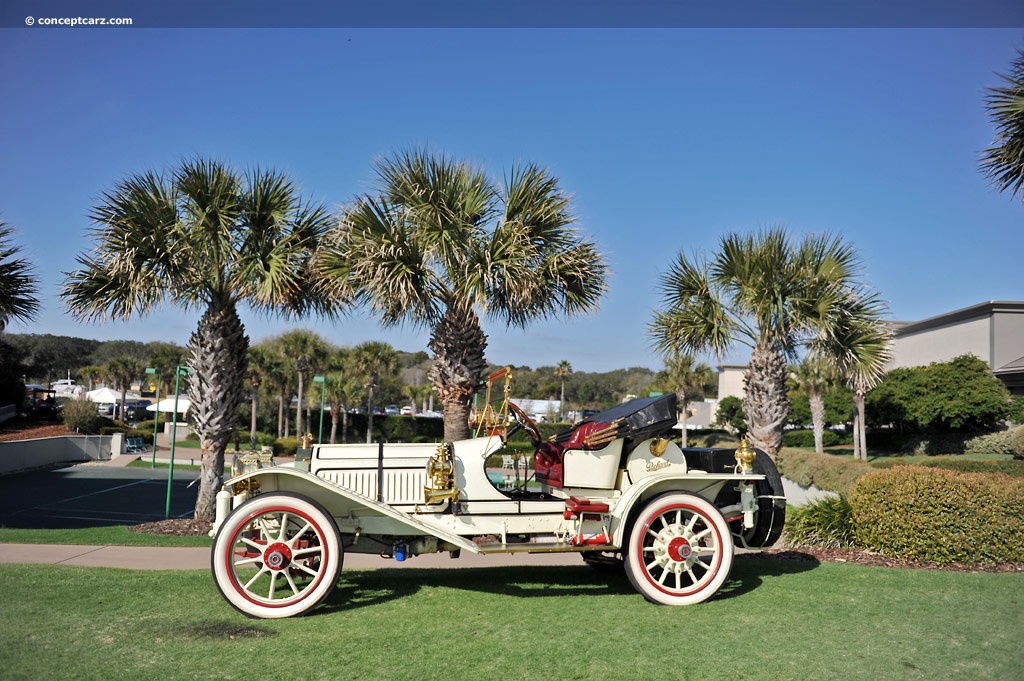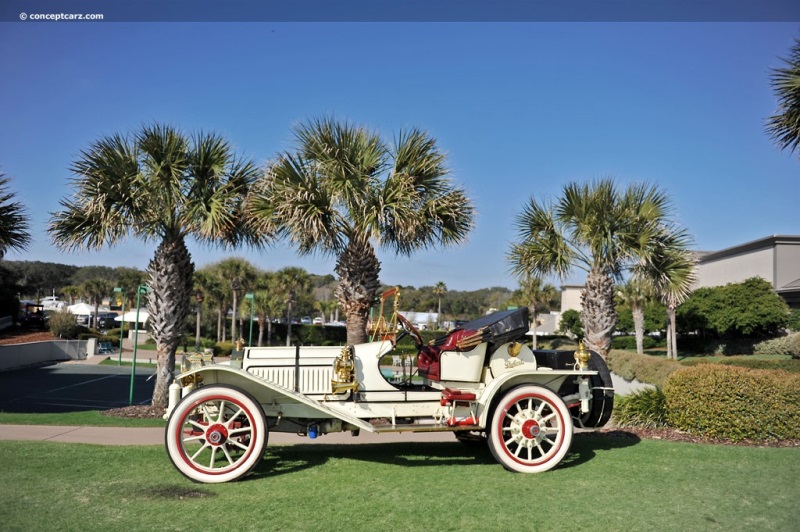James Ward Packard entered the motoring arena as the nineteenth century was coming to a close, buying a Winton motor car in 1898. His purchase was problematic and after an unfruitful conversation with Scotsman, Alexander Winton about his creation, Packard decided that he could do better and so set about building his own gasoline motor buggy. Enlisted the services of his brother, William Doud Packard, and Winton's key men, George Weiss and William Hatcher, James Ward built his first automobile at the family's Warren, Ohio transformer factory. It emerged on November 6th of 1899 for a test run that was covered in the Warren Tribune, stating 'the successful completion of the machine will probably mean a factory for automobiles in this city.' Motor car production began in earnest in Warren and it was not until 1903 that production shifted to Detroit.
Runabout
Chassis #: 23684
View info and history
Auction entries : 1The Ohio Automobile Company was formally established in 1900 and production that year reached 49 motorcars. The Model B used a similar configuration to the 1899 prototypes with a conventional single-cylinder, four-stroke engine driving through a planetary transmission system, with final drive by chain. The company's H-pattern gearshift and automatic ignition advance were very advanced features and would later be adopted across the industry. The Piece de resistance occurred at the New York Automobile Show late in 1900 when William D. Rockefeller switched his allegiance from Winton and ordered a Packard. A twin-cylinder Packard model, the Model G, was introduced in 1902 but it proved unpopular. Ever the astute businessman, Packard moved on and announced the first four-cylinder car, the Model K, in the Fall of 1902. That same year, the Packard Motor Car Company was established and a new factory was set up in Detroit in 1903. The new four-cylinder cars were quickly entered into motorsport competition, with designer Charles Charles Schmidt taking the wheel himself and driving to a creditable fourth place in the first Vanderbilt Cup race in 1904. At Daytona, the Packard achieved a remarkable 77.6 mph mile record.The durability and reliability of the Packard vehicles, the advanced mechanical designs, and the accomplishments in motorsports helped production exceed 200 units in 1904, a first for the young company. 1904 models had a 241.7 cubic-inch displacement while the 1905 models grew to 265.7 cubic inches. The Model S of 1906, otherwise known as the Model 24, featured for the first time a 'T' configuration cylinder head and magneto jump spark ignition. The Model Thirty (the first Packard to indicate its engine power in the model name) that followed was a development of the Model S, employing the highly efficient T-head engine which now displaced 431.9 cubic inches and offered 30 horsepower (ALAM). The formal touring car, landaulette, and limousine body styles rested on the longer 122-inch wheelbase chassis, while the sporty persona of the Runabout was better suited to the 108-inch wheelbase. Sales and production of the Model Thirty peaked in 1910 with 2,493 units, climbing gently down to 1,865 units in 1911, before the arrival of their six-cylinder cars in April 1911 curtailed the Model.
Tourer
View info and historyPackard's six-cylinder model solidified its reputation as a leader in the luxury car segment, offering ease of operation, quality, performance, durability, and comfort. The Model 48 (for its rated horsepower), also referred to as the Dominant Six, was the new top-of-the-line model, developed a full 74 horsepower at 1,720 RPM. Packard advertisements at the time proudly proclaimed that it would reach '60 miles per hour in 30 seconds from a standing start.' It used the company's float-feed carburetor with automatic mixture control and a Bosch dual ignition system. Prices started at $5,000 and ranged upward to $6,550. Thirteen body styles in various configurations were offered on wheelbases from 121.5 to 139 inches. A total of 1,350 examples were sold in the first year of production and in the summer of 1912, the new 1913 Model 2-48 was introduced, with eight more brake horsepower, electric headlamps, and improved lubrication. Additionally, the fuel tank was relocated to the rear, and its previous location - under the driver's seat - was used to store the battery and toolbox (which had previously resided on the running boards). The Model 3-48 (sometimes called the 'New 48') arrived in early 1913 and had a combination starter-generator and left-hand drive. The fourth iteration of the 48, dubbed the 4-48, arrived in February 1914. The wheelbase grew to 144 inches and numerous improvements were made to the engine. It continued to retain the 415 cubic inch displacement size as the previous '48s' but instead of three blocks of two cylinders, it had two blocks of three and seven main bearings and was of L-head configuration. During its five months of production, through June of 1914, a total of 441 examples were built.
by Daniel Vaughan | Sep 2022

Runabout
Chassis #: 23684
View info and history
Auction entries : 1

Tourer
View info and history
by Daniel Vaughan | Sep 2022
Similar Automakers
1912 Packard Model 1-48 Vehicle Profiles
Recent Vehicle Additions
Performance and Specification Comparison
Price Comparison
$3,200 - $4,600
$4,200 - $5,750
Model 48 Specification Comparison by Year
Year
Production
Wheelbase
Engine
Prices
Related Automotive News

BEACH CARS STORM THE 2014 AMELIA CONCOURS d'ELEGANCE
For an event like The Amelia a class of beach cars is appropriate and ideal, said Warner. After all, when you take a break from the concours field and sit on the veranda at the Ritz-Carlton with a cool drink in front of you, you stare at the ocean...

RM Auctions Amelia Island Preview - 2014
0
RM Auctions, the worlds largest auction house for investment-quality automobiles, will hold its Amelia Island, Florida, sale on March 8th at the Ritz-Carlton.
As the official auction house of the Amelia Island Concours dElegance, RMs...

Gooding & Company Amelia Island Auction Preview
Gooding %26 Company, the auction house acclaimed for selling the worlds most significant and valuable collector cars, will hold its annual Amelia Island Auction on Friday, March 7 on the Omni Amelia Island Plantation.
David Gooding, President and founder...

AUDI MAKES SEBRING THE ‘HOME OF QUATTRO'
First race for the Audi R18 e-tron quattro in the USA
Farewell event for LMP1 class with historic automobile exhibition
Dr. Wolfgang Ullrich Emotional race weekend
Ingolstadt, March 8, 2013 – It is a debut and a farewell at the same t...

First Audi overall victory in the Nürburgring 24 Hours
- One-two finish in Germanys greatest race
- Next historical milestone after Le Mans and Spa
- Triumph for Audi Sport Team Phoenix in its home race
Erratic weather, an extreme pace, tough competition, bitter setbacks and a great triumph Audi emerged...
























